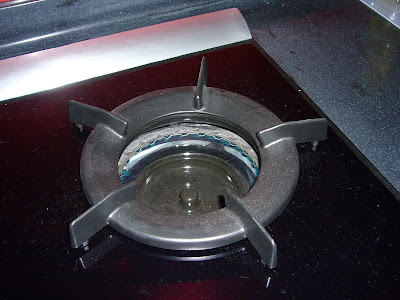
Ceran glass panel top :
 Seal of quality ceramics glass on Rinnai RB-2CG
Seal of quality ceramics glass on Rinnai RB-2CG Thickness of glass ceramics
Thickness of glass ceramicsInner-Flame Burner :

Rinnai Corp., Nagoya, Japan, has turned burner design completely around with its inner-flame burner. Instead of shooting flames outward from the burner perimeter, as with a conventional burner, Rinnai’s inner-flame burner is ported so that flames shoot inward toward the center.

The purpose of the unusual design is to create a coherent, unified flame that rises under the center of a pan, then flows outward, bathing the entire bottom of the pan in flame. This approach heats the pan with greater uniformity and improves the efficiency of heat transfer from the flame to pan, which is good for even frying without getting burned food.
In addition to aiming the ports inward, two other design factors assist in shaping the flame. One is that the burner sits slightly below the surface of the cooktop, helping the individual flames to coalesce toward the center as they rise through a hole in the cooktop surface.

Secondly, and more importantly, the burner ports are angled slightly on the horizontal plane. The effect of the flames shooting out an angle is to create a fiery vortex. The swirling flame is meant to accomplish two things. One, it assists in driving the flame outward across the bottom of the pan, helping to evenly bathe the pan bottom with flame. Two, the vortex creates a pressure drop that assists in drawing air in for combustion allowing for a strong consistent flame.
 We got a good price of $1400 at that time(Nov 2007) for a package purchase of a Rinnai RB-2CG(LPG) hob and RH-988C Glass hood from Mega Discount Store at Katong Mall. We chose a 2 burner hob because a 3 burner hob would be a tight squeeze for practical cooking given the size of saucepan and pots and usually, it is practical and safe to handle 2 burners at any one time. For the RH-988C, we like the flat and squarish modern design which fits in the modern contemporary look. Air flow is more than adequate given that in real life, we do not cook at restaurant level of cooking. Importantly, there are built-in downlights to aid in cooking.
We got a good price of $1400 at that time(Nov 2007) for a package purchase of a Rinnai RB-2CG(LPG) hob and RH-988C Glass hood from Mega Discount Store at Katong Mall. We chose a 2 burner hob because a 3 burner hob would be a tight squeeze for practical cooking given the size of saucepan and pots and usually, it is practical and safe to handle 2 burners at any one time. For the RH-988C, we like the flat and squarish modern design which fits in the modern contemporary look. Air flow is more than adequate given that in real life, we do not cook at restaurant level of cooking. Importantly, there are built-in downlights to aid in cooking. RB - 2 CG Cooker Hob
RB - 2 CG Cooker Hob RH - 988 C Cooker Hood
RH - 988 C Cooker Hood
1 comment:
Hi, nice blog, nice inner burner, intersted to get one, but like to learn more. Would you be able to share experience on the Burner maintenence? like how you handle soup overflow massively... is it easy to clean? Conventional burner tends to choke up by carbon and fire turns reddish, over prolong usage, the burner cap tends to burnt out and wear out as well, does these happen to inner burner?
Post a Comment